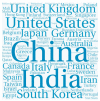Research Trends and Future Perspectives in Marine Biomimicking Robotics
- PMID: 34072452
- PMCID: PMC8198061
- DOI: 10.3390/s21113778
Research Trends and Future Perspectives in Marine Biomimicking Robotics
Abstract
Mechatronic and soft robotics are taking inspiration from the animal kingdom to create new high-performance robots. Here, we focused on marine biomimetic research and used innovative bibliographic statistics tools, to highlight established and emerging knowledge domains. A total of 6980 scientific publications retrieved from the Scopus database (1950-2020), evidencing a sharp research increase in 2003-2004. Clustering analysis of countries collaborations showed two major Asian-North America and European clusters. Three significant areas appeared: (i) energy provision, whose advancement mainly relies on microbial fuel cells, (ii) biomaterials for not yet fully operational soft-robotic solutions; and finally (iii), design and control, chiefly oriented to locomotor designs. In this scenario, marine biomimicking robotics still lacks solutions for the long-lasting energy provision, which presently hinders operation autonomy. In the research environment, identifying natural processes by which living organisms obtain energy is thus urgent to sustain energy-demanding tasks while, at the same time, the natural designs must increasingly inform to optimize energy consumption.
Keywords: bibliographic statistics; biomaterials; energy provision; locomotor designs; marine biomimetics; optimal energy consumption.
Conflict of interest statement
The authors declare no conflict of interest. The funders had no role in the design of the study; in the collection, analyses, or interpretation of data; in the writing of the manuscript, or in the decision to publish the results.
Figures







References
-
- Degnarian N., McCauley D. 12 robots that could make (or break) the oceans. World Economic Forum. [(accessed on 11 April 2021)]; Available online: https://www.weforum.org/agenda/2016/09/12-cutting-edge-technologies-that....
-
- Fu K., Moreno D., Yang M., Wood K.L. Bio-inspired design: An overview investigating open questions from the broader field of design-by-analogy. J. Mech. Des. 2014;136:111102:1–111102:18. doi: 10.1115/1.4028289. - DOI
Publication types
Grants and funding
LinkOut - more resources
Full Text Sources

